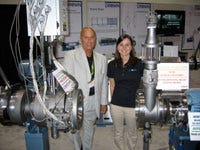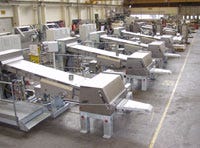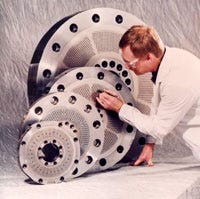It all starts with the pellet
Well, maybe it starts with the idea, but without perfect pellets a processor has little to no chance of success. Fortunately, there have been a number of significant developments recently in the pelletizing machinery field, including some highlighted at June’s NPE trade show in Chicago.
July 29, 2009
Well, maybe it starts with the idea, but without perfect pellets a processor has little to no chance of success. Fortunately, there have been a number of significant developments recently in the pelletizing machinery field, including some highlighted at June’s NPE trade show in Chicago.
There, for the first time, Crown Machine uwp Inc. (Addison, IL) revealed its newest development, a system that is truly a one-button operation and requires no centrifugal dryer but offers twice the efficiency, according to George Holmes, founder and owner of the company. Speaking with MPW at NPE, Holmes called his development “the only true auto-start pelletizer available.” Magnets release to allow access to the die, with the rear part of the unit returning to the rear as per the bolt on a rifle, so that die changeover is swift and even a change from black to white pellets is possible in just a few minutes. The magnetic clamp is patented and was shown for the first time at NPE.
Crown’s George Holmes (left) and Amy Nepywoda, design engineer, provide the backdrop at the company’s NPE stand for its newest pelletizing unit. |
Also at NPE, Automatik Plastics Machinery GmbH (formerly Rieter Automatik; Grossostheim, Germany) introduced its Baoli strand pelletizer, designed specifically for the U.S. compounding market. The manufacturer says the system is cost-effective in terms of purchase price and running costs, and available in three basic machine sizes with operating widths of 100, 200, and 300 mm.
In early July, Automatik announced the sale and installation of four new strand pelletizing systems for use in a new polyamide supply facility in Europe. The four horizontal lines are based on the M-USG 600 H underwater strand pelletizer, each with a throughput capacity of 3200 kg/hr. Each of the systems includes a fluid-headed die head to melt the feed and extrude the strands, a horizontal strand guide section, the pelletizer, and a Centro 300 centrifugal dryer to remove process water from the cylindrical pellets.
The Converting Systems Group of Davis-Standard (Fulton, NY) recently added new pelletizing technology to its Black Clawson Converting Machinery range. Charles Crumb, business group manager at the company, told MPW redesigned dies with more holes per die were developed, increasing throughput, and the die plates have been strengthened to increase service life by 25-30%. These dies are retrofittable on installed systems, he said.
The company also added a new air ring pelletizer to its mix of underwater and water ring equipment, with the new system to help users process materials with low internal energy or hydroscopic materials. Black Clawson’s pelletizers may be unique in that the die is fitted parallel to the ground.
Gala Industries Inc. (Eagle Rock, VA) has introduced The Edge, an underwater pelletizing unit it says is able to compete on cost with strand pelletizers, while offering the benefits of an underwater system, such as no strand breakage on highly-filled concentrates. The Edge is compact and suitable for throughput to 1000 kg/hr. Low maintenance requirements and minimum operator attendance are two of the key advantages, claims Gala, along with low noise levels and swift start-up times.
Gala also introduced its Electronically Adjusted Pelletizer (Model EAC), with electronic motion control used to control blade adjustment down to 0.0001 inch (patent pending), according to Steven King, process equipment sales at the 100% employee-owned company.
In related news, Scheer Bay early this summer ended its joint venture with CF Scheer after more than 10 years. Insolvency proceedings for CF Scheer were opened in Germany on Oct. 1, 2008 and its operating assets were sold. “Scheer Bay Co. has always been independent of CF Scheer and was not part of the sale,” said Tom Kernstock, executive VP, who added that the company will continue to operate under its original name, Bay Plastics Machinery Co., from its facility in Bay City, MI, and will continue to support its existing customers with parts and service for their equipment. —[email protected]
About the Author(s)
You May Also Like





